PRESIDENT'S PLAN: DOING OUR PART
Ever since Jean and I moved into our house fifteen years ago, we have mulled over what to do with the kidney-shaped mound at the end of our lawn in our back yard. Should we dig a garden? Perennials? Shrubs?
Perhaps Sean James' presentation at the PFN March meeting was the final nudge we needed. It was decided. A native plant and flowers for feathered friends garden it shall be. First came the Serviceberry Jean purchased from John Potter at the Malcolmson Ecopark Native Plant Sale in May. Then the outline was staked and followed by tough digging. With the Serviceberry planted, additional plants were strategically placed. Beard Tongue, Blanket Flower and Butterfly Weed now accompanied the small shrub. I brought home some Milkweed seedlings from the NPCA office and after planting them, Sunflower seeds were sowed around the edges of our new garden.
It did not look promising at first. House Sparrows dusting themselves in the earth soon discovered the hidden treasure. Luckily, some seeds provided by Brian Calvert remained and started to grow. Brian was unsure of the species but said they were tall. And they are! Seven to eight feet in height with multiple blooms. Pollinating insects have been visiting the Sunflowers and soon we should have Blue Jays and American Goldfinches feeding on the seeds. The Sunflowers may need to be controlled next year to give the Serviceberry some elbow room.
Green Cone Flower and Obedient Plant have taken hold in our side garden and have attracted insects for three summers now. Bee Balm provided by Carol Horvat added a nice colour of red to the side garden and attracted a Ruby-throated Hummingbird last summer. It's a work in progress but I think Jean and I have a great start at attracting insects and birds to a yard nestled near the downtown of the city of St. Catharines.
The Club is a vibrant entity, sometimes with new members arriving, or long-term members departing.
Recent departures: Joyce Auty and David Moore
Recent new arrivals: Lynn Glover; Beverly and Christofer Hadler; Tina Masmeyer; Joan Michon
Please advise the Editor if you are aware of other arrivals or departures. It helps us keep in touch...

ROCK POINT AREA AND BANDING STATION OUTING
On May 30, Rick Young led the trip to the Rock Point area which included a visit to the Rock Point Bird Banding Station. The Station is nestled in the woods at the west end of the Provincial Park, and the PFN members were able to observe the procedure of banding captured birds that were recovered from the nets surrounding the Station. Once data is collected and a bird is banded, it is set free to continue on to its breeding grounds. While at the Station, our group had the pleasure of observing an Orchard Oriole perched at the top of a conifer, and Rick pointed out a flowering Small Yellow Lady's Slipper in a secluded spot nearby.
Our group spent the rest of the morning exploring the woods and shoreline of the Park. Shorebirds observed included Killdeer, Semipalmated Sandpiper, Spotted Sandpiper, and Ruddy Turnstone. After lunch, we birded spots in the Rock Point area and along the Lake Erie shoreline when returning to Niagara. A pleasant day for all.
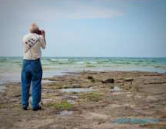
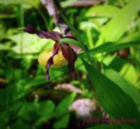
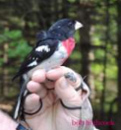
2015 JUNE PFN PICNIC
The PFN annual picnic was once again held at the house and home of Don and Sue Minchin, on the sunny day of June 6/2015. When we arrived, an immediate point of interest was the large pond behind the Minchin's house, the pond being virtually free of cattails. Don explained that removing the cattails improved the scenery and also discouraged muskrats. Also, Phragmites growth had been developing on the west side and was removed. The lack of tall vegetation surrounding the pond was surely disturbing to the Redwing Blackbirds.
For a birding tour around the property, Don led the walkers while Sue transported the less-active members in a golf-cart-type vehicle, an upscale conveyance from the tractor that has been used previously. Don noted that his honey-bee hives were seeming less productive than in previous years, probably for the same reasons as commercial bee-keepers have experienced. However, the Bluebirds appeared to be producing baby birds, so all was well in that department. Don said they had fledged 22 Bluebirds, many Tree Swallows, 10 Chickadees, but only one nest of Purple Martins. Two of his nest boxes had flying squirrels.
We were advised that the pond was now inhabited by large-mouth bass, some of which were hanging around in the water near a small dock. Sunfish and several mud turtles also enjoy the water. An after- lunch activity for some of the members was tossing bits of food into the water and remarking at the size of the bass as they grabbed up the left-overs. Again, thanks to the Minchin's for a very relaxing and enjoyable day! (Note: see Photo on Page 4)
"THE OTHER END OF MIGRATION"
Our speaker Lev Frid, on September 28/2015, sub-titled his talk: "The lives of Canadian songbirds in the New World tropics". Lev is presently employed at Algonquin Park and has been there for 7 years doing what he called "the usual summer jobs". He also has a private company called "Boreal Nature Tours", has guided in Costa Rica, and is familiar with most of Central America. His presentation included information and photos of how 'native' birds of Ontario live and change their looks while wintering in their various locations in the Tropics, and also discussed the appearance and activity of native birds in Central America.
Lev explained that many of the birds that migrate south become different animals when they are on their winter grounds. He mentioned that Cedar Waxwings sometimes go, in what is called an 'irruption', en mass to Costa Rica and may winter there in the millions. Because of their diet of fruit, their feathers may change colour, and tail-feathers may be orange instead of the yellow that we are used to seeing. A photo of a Scarlet Tanager in its winter plumage showed it being yellow on all of the plumage that would be red here. In our North America bird-books, illustrations and photos show the colours and "native" plumage that we expect to see in Ontario, but these birds might look totally different in the tropics.
Lev also mentioned that Pewees may travel to Costa Rica and Peru, and are known to sing a different song on their territory in the South, than the song we expect to hear in Ontario.
Another unexpected fact was that bird species that live in the Tropics full-time may also go through a 'migration' of a different sort. For example, the Quetzal bird native to Costa Rica is known to seasonally change its location, from living higher in the mountains to going lower into the valleys, somewhat simulating the atmospheric change that Canadian northern birds go through when they fly south in winter.
The Bobolink, which we know to be in decline in Ontario because it lacks nesting areas, migrates to Brazil and Argentina, where the Pampas provides nesting places, and food in the form of rice. Lev stated that the birds eat so much rice that the farmers try to reduce the damage in some places by spraying a pesticide which kills or repels the birds. Oddly, Swainson Hawks also make this migration, and may eat grasshoppers which have poison on them.
Several examples of Ontario birds' migrations were mentioned in Lev's talk. Chickadees and Nuthatches migrate to Central America; Grosbeaks and Tanagers travel to Costa Rica; Coopers Hawks migrate to Mexico; and the Ruby-throated Hummingbird is a known migrant, although Central America and Costa Rica particularly are home to many resident species of hummingbirds. These small birds may sometimes become the prey of snakes in that area.
Lev mentioned that ants are a food for many bird species. However he recounted having seen a stream of Army-ants on a path, being followed by an Ovenbird that was eating insects stirred up by the Army-ants. He also mentioned that some hawks may predate smaller birds as the latter are attacking the ants.
The foregoing information, which your Editor was able to transcribe while gawking at Lev's gorgeous bird photographs and attempting to capture his wealth of ornithological knowledge, is only a smattering of what Lev presented to us. Note to Program Committee - More, More, More, Please!!
Thanks to Marlene Sanders for obtaining our fascinating Speaker!
NATURE IN THE CITY
On June 18th, an intrepid group of PFN members gathered for a Thursday evening walk at Jaycee Park in St. Catharines. Unfortunately, due to threatening thunder clouds, our hike was shortened and photoless. We did see a nice assortment of birds including Eastern Kingbird, Yellow Warbler, Baltimore Oriole, and Great Crested Flycatcher. We walked across the bridge to Rennie Park in Port Dalhousie. This is a great place to view Barn Swallows and Cliff Swallows because they nest underneath the bridge. The outing culminated with an ice-cream cone treat before we hurried back across Martindale Pond to escape the oncoming rain.
GLENRIDGE QUARRY NATURALIZATION SITE OUTING
The Glenridge Naturalization Site is a former quarry that was used as a municipal landfill and now offers trails and lovely escarpment vistas. The PFN visited the site the morning of Sunday October 18. Our main objective was to identify different species of sparrow and we were able to find Song-, White- throated and White-crowned Sparrows as well as Dark-eyed Juncos. We found both Ruby-crowned and Golden-crowned Kinglets, Black-capped Chickadees, House Finch, and Eastern Phoebe. Turkey Vultures circled lazily overhead. After walking the trail loop, some of us climbed to the Summit Overlook to a spectacular 360 degree view of our Region. Some wildflowers were still in bloom and the goldfinches were feeding on seeds. The fall colours put on a good show and everyone had an enjoyable morning
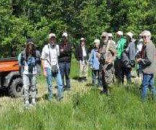
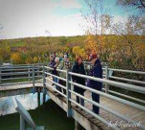
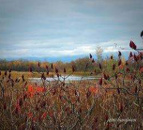
PFN MUD LAKE OUTING
On October 25, our small group had no issue walking the entire Blue Heron Trail at Mud Lake Conservation Area in Port Colborne. Hiking the 3.1 km loop was such a success last year that the fall hike is now an annual event.
Waterfowl observed on the lake included the ubiquitous Mallard, Wood Duck, Green-winged Teal and Northern Pintail. At the north end of the lake, we found 6 Lesser Yellowlegs and 1 Pectoral Sandpiper feeding in the shallows. As we followed the curving trail through the brush east of the lake, a Rusty Blackbird was spotted but it moved on before all could see it. Thankfully, the Rusty Blackbird reappeared and all were able to get a good view through a scope as it sang while perched on a tree. A lifer for Marlene!
For more than two hours we hiked along the trail loop observing 24 bird species, leopard frogs, an interesting mushroom species and the beautiful fall colours. Based on the remarks after the outing, the fall in 2016 is already planned.
"HONEY BEES: THE DECLINE AND EFFECTS"
Paul Kelly, our speaker at the October 2015 meeting, is a research and teaching scientist at the Honey Bee Research Centre on the Guelph University campus. By the Club's good fortune, Julie Falsetti (Marlene Sander's daughter) was an intern at Paul's lab, which helped to secure him as a speaker.
Beginning with some facts about the Centre, Paul noted it has 300 hives in total; from its teaching and research, the Centre produces 43 barrels of honey each year; 700 students each year take the bee-keeping courses; and it is advisable to take a bee-keeping course if one wants to become a bee-keeper.
The Centre uses the traditional equipment, such as the hive-boxes with supers, the smokers for working on the hives, and the wax forms for the comb. In the hives, bees maintain a 34 C temperature year-round by using their wings; bees develop from egg to larva, pupa and adult, in stages which a bee-keeper can identify in the hive by their appearance. Queens have to be produced either when an old queen is dying, or when a hive is about to swarm. The worker bees make either queen-jelly or worker-jelly to determine the sexes of new bees in the hive. A queen can produce several times her own weight in eggs, and may carry 7-million sperms which are supplied by the drones; drones die after mating (their only purpose).
Besides honey, other products from bees are bees-wax, produced from special glands on the bees, and used by humans in candles, lip balms, creams; and pollen, a source of protein, collected by the honey-bees and harvested and sold to humans. Some pollen is sold to owners of tomato greenhouses, where bumblebees are used for pollinating the plants. Honeybees can't pollinate tomatoes, but their gathered pollen is fed as protein to the bumblebees. Paul told us that pollen is variously coloured from some flowers; poppy pollen is black; chestnut pollen is bright red; but many pollens are yellow, including saffron from crocus which is used as a food flavouring and colouring. Paul demonstrated (with his own legs and arms) how the bees collect pollen which sticks to hairs on their legs, and is carried to the hive. The demonstration caused much merriment.
Paul stated (and demonstrated, humorously) that honeybees perform a 'dance' which can tell other bees how far and in what direction they should go to a pollen source - a dance forward for the direction, and then the opposite way for distance. He said that honeybees do not pollinate grasses (including grain crops and corn), but world-wide, there are 20-30,000 other species of bees in the world.
Honeybees can die from various reasons. Paul noted that honeybee losses over winter can be about 35%, and other causes include bad weather, malnutrition, diseases, predators, and pesticides. Predators include Varroa mites and Tracheal mites, but oxalic acid will kill some mites without hurting the bees. The Canadian honeybees have become resistant to Tracheal mites. Another internal parasite of honeybees is a fungus called Nosema. The latest problem for honeybees became noticed in 2012-2013 when the bees began to die in the early spring from poisoning by a new pesticide 'neonicotinoid'. This chemical was being used on wheat, soybeans and seed corn, with all corn seed being treated with it. The pesticide was also found on the soil, in water on fields, and on plants. An amount at 3 parts/billion on the soil was toxic to honeybees. The beekeepers now have a law passed by the Ontario government, requiring farmers to prove that they need to use this pesticide. Members may remember that Miriam Richards spoke to the PFN about bees in 2013 and mentioned that this pesticide was dangerous to all kinds of bees.
In summing up, Paul Kelly made several suggestions of how to be honey-bee friendly: eat local produced honey; plant flowers; don't spray roadside plants; allow land to naturalize; and support research on honeybee health.
BIODIVERSITY OFFSETTING : SHOULD WE WORRY?
We humans are constantly changing our surroundings, often for reasons that we deem necessary. However, most other living inhabitants on the planet lack the luxury or the ability to choose or to make significant changes to their surroundings. Except for a few species, most living organisms live (or survive) in places not of their choosing and must adapt to those conditions. To understand how "Biodiversity Offsetting" might affect them, we should first understand the meaning of "Biodiversity" and of "ecosystem".
An 'ecosystem' may be a forest, a wetland, a complex grassland, or any other area in which various species of living organisms live. These species may include animals, plants, insects, microbes, fungi and all other living organisms, with all the genetic variations of each organism. The ecosystem also includes the physical properties (soil types, water, temperature, air, climate) that allow the set of living organisms to live in that location.
'Biodiversity' then is a short-form for 'Biological Diversity' and applies to a site where a unique complex of organisms have developed over a period of time under a distinct set of physical properties. Because of the variation in any of the biological or physical properties of each ecosystem, no two ecosystems are alike. Therefore, thinking that trading of one ecosystem (as in a wetland, or forest, or complex grassland) for another ecosystem is possible without any differences, is naïve, misrepresentative or just plain wrong.
The difficulty with 'Biodiversity Offsetting' can be explained by this theoretical example: You own an acre of land with a pond on it, and a developer wants your acre for development and offers to trade to you a different acre of land with a pond half a mile away. Because the developer's land is not the same as yours, you will not acquire an exact replica of your land if you accept the trade. The acre you accept may have different plants around the pond, or different turtle species in the pond, different water conditions, a different soil type - whatever. A Biodiversity Offsetting land-trade can not and will not return to you an exact copy of what you gave in exchange.
Put another way: If you engage in a Biodiversity Offsetting land-trade, receiving an exact biological replica of your original land is impossible.
The Ontario Government's "Ontario Biodiversity Council" in 2005 had concerns about Ontario's biodiversity, including 6 perceived threats, namely: Habitat Loss; Invasive Species; Population Growth; Pollution; Unsuitable Use; and Climate Change. Among the strategic directions for action against these threats were these: "Reduce pressures on biodiversity", and: "Protect Ontario's genetic, species, and ecosystem diversity". That was 2005. This is 2015. So what is our status now?
Well, in 2013, Ontario Nature initiated a project on Biodiversity Offsetting, with the goal to ensure that, in Ontario, Biodiversity Offsetting would truly benefit the natural world. A publication called "Insights into Biodiversity Offsetting in Ontario" was prepared and released by Ontario Nature in 2014.
In this publication, on page 2, Ontario Nature stated: "Biodiversity Offsetting engages developers in compensating for the damage resulting from development projects. The offset involves a transaction between developers (seeking to compensate for destroying or damaging elements of biodiversity, such as species and their habitats) and offset providers, including landowners, farmers, conservation organizations and First Nation communities, that are able to restore, create and manage habitat for species elsewhere."
The publication noted: "Biodiversity Offsetting is emerging in many countries as a promising market- based mechanism to compensate for harmful impacts to wild species and ecosystems caused by development."
Ontario Nature also stated: "If implemented correctly, Biodiversity Offsetting could 1) position industry as a positive force in biodiversity conservation efforts; 2) ensure that offset providers (farmers, First Nation communities, conservation organizations, etc) had the financial means to undertake conservation efforts on their lands; and 3) provide an overall net gain for biodiversity. Lacking, however, are the shared understanding and policies needed to guide the implementation of Biodiversity Offsetting in Ontario and to address the significant risks that it entails."
What is worrisome in the Ontario Nature publication are the 'weasel-words' like "If implemented correctly...." and "Lacking, however, are....".
In the Conclusion (pg.32), it notes: "There is also a deep unease about: 1) scientific uncertainties; 2) the actual ability to ensure that offsetting results in a net gain for biodiversity; 3) the need to set clear limits around vulnerable or irreplaceable natural features; and 4) the lack of a clear policy framework."
However, Ontario Nature was able to obtain from their project participants the support for seven principles:
- Offsetting should be set within a clear mitigation hierarchy. First, negative impacts should be avoided wherever possible. Second, any unavoidable negative impacts should be minimized to the extent possible. Offsetting then offers a means to deal with residual impacts that cannot be addressed through avoidance or minimizing harm.
- Offsetting should require achievement of an overall net gain.
- Some sites, features and habitats should be off-limits to offsetting, based for example on vulnerability and irreplaceability. The "no-go" criteria should be informed by science and Aboriginal Traditional Knowledge.
- In establishing equivalence, the offset must take into account not only quantity (size) but also quality with respect to the condition of both sites and their landscape context.
- The outcomes secured through an offset should last at least as long as the project's impacts, and ideally in perpetuity.
- The offset location should be based on desired conservation outcomes.
- The pricing of offsets should cover the complete costs of the delivery of the offsets (including costs of entering into an agreement, creation and maintenance of the offsets, monitoring and reporting).
It is significant that the Chairman of the Ontario Biodiversity Council, commenting on the need to address economic growth, stated in the Ontario Nature publication:
"First, ecologically significant, highly vulnerable and irreplaceable sites, features and habitats should be avoided wherever possible."
SHOULD WE WORRY? That depends on how much you wish to "Protect Ontario's genetic, species, and ecosystem diversity".
(Copies of the 36 pp. publication "Insights into Biodiversity Offsetting in Ontario" can be down-loaded on the Internet. Address: ontarionature.org/offsetting. )
UPCOMING EVENTS
The end of one year and the beginning of another always brings a busy time for naturalists - besides New Years Eve, that is. With that in mind, here are some of the interesting events to look out for:
St. Catharines (PFN) Christmas Bird Count: December 20, 2015 - Contact Marcie Jacklin (905-871-2577) re Birding;
After-Birding Roundup at North Pelham Youth Center - contact Mary/John Potter (905-892-2566)
Niagara Falls (NFNC) Christmas Bird Count: Decmber 27, 2015
Port Colborne-Buffalo (BMNC) Christmas Bird Count: January 2, 2016
Lake Ontario Mid-Winter Waterfowl Inventory (Duck Count): January 10, 2016
PFN SPEAKERS:
January 25, 2016: Speaker - Loretta Shields; Topic: Wind Turbines
February 22, 2016: Speakers - John Black & Marcie Jacklin; Topic: Birding Colombia
OUTINGS: PFN ANNUAL Maple Syrup Walk at Roland Road, Short Hills PP, with pancake lunch at White Meadows Farms after the hike
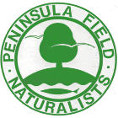
The Peninsula Field Naturalists Club
A non-profit organization started in 1954 with the objectives to preserve
wildlife and protect its habitat, to promote public interest in and a knowledge
of the natural history of the area, and to promote, encourage and cooperate with
organizations and individuals having similar interests and objectives.
Affiliated with Ontario Nature and Nature Canada.
P.O. Box 23031, RPO Carlton, St. Catharines, ON. L2R 7P6
Website : peninsulafieldnats.com
The Peninsula Naturalist
Published: February, April/May, October/November
The Editor welcomes written articles or artwork on any natural history topic.
Please submit typed reports on paper or by email to: jmpotter068@gmail.com
Colour photos (jpg) accompanying articles are welcome. All pieces of artwork
will be accepted. New ideas and constructive criticism are welcome. Please send
submissions by email to e-address above, or by snail-mail to the Club’s postal
address.
Editor: John Potter
Assistant: Mary Potter
–
The Peninsula Naturalist Newsletter,
Published: February, April?; October/November
Download the complete newsletter pdf
